Related Research Articles
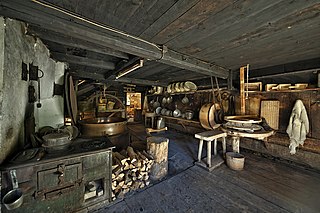
A dairy is a place where milk is stored and where butter, cheese and other dairy products are made, or a place where those products are sold. It may be a room, a building or a larger establishment. In the United States, the word may also describe a dairy farm or the part of a mixed farm dedicated to milk for human consumption, whether from cows, buffaloes, Goats, sheep, horses or camels.

The Common Agricultural Policy (CAP) is the agricultural policy of the European Union. It implements a system of agricultural subsidies and other programmes. It was introduced in 1962 and has since then undergone several changes to reduce the EEC budget cost and consider rural development in its aims. It has, however, been criticised on the grounds of its cost and its environmental and humanitarian effects.

Agricultural policy describes a set of laws relating to domestic agriculture and imports of foreign agricultural products. Governments usually implement agricultural policies with the goal of achieving a specific outcome in the domestic agricultural product markets.
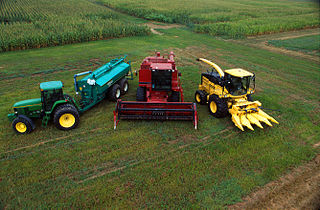
An agricultural subsidy is a government incentive paid to agribusinesses, agricultural organizations and farms to supplement their income, manage the supply of agricultural commodities, and influence the cost and supply of such commodities.
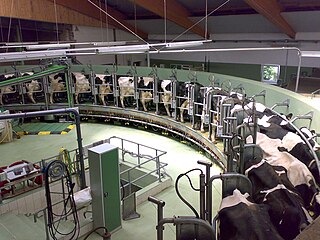
Dairy farming is a class of agriculture for long-term production of milk, which is processed for eventual sale of a dairy product. Dairy farming has a history that goes back to the early Neolithic era, around the seventh millennium BC, in many regions of Europe and Africa. Before the 20th century, milking was done by hand on small farms. Beginning in the early 20th century, milking was done in large scale dairy farms with innovations including rotary parlors, the milking pipeline, and automatic milking systems that were commercially developed in the early 1990s.

Fonterra Co-operative Group Limited is a New Zealand multinational publicly traded dairy co-operative owned by around 9,000 New Zealand farmers. The company is responsible for approximately 30% of the world's dairy exports and with revenue exceeding NZ $22 billion, making it New Zealand's largest company. It is the sixth-largest dairy company in the world as of 2022, as well as the largest in the Southern Hemisphere.
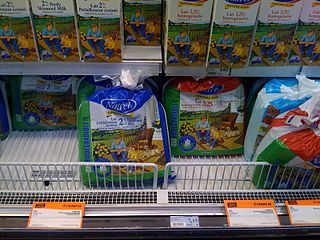
The Canadian Dairy Commission is an Ottawa-based Government of Canada Crown Corporation that plays a role of administrator, facilitator and stakeholder in the public policy related to the Canadian dairy industry. The CDC's mandate is to coordinate dairy policies in a jurisdiction that is shared between both provincial and federal governments. In the early 1970s, when the dairy industry became the first industry in Canada to be operated under the national supply management system, the CDC was named as facilitator and administrator coordinating dairy policies and providing a framework for the management of the Canadian dairy industry.
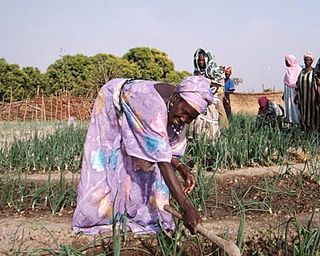
An agricultural cooperative, also known as a farmers' co-op, is a cooperative in which farmers pool their resources in certain areas of activity.

Agriculture, farming, and fishing form the primary sector of industry of the Japanese economy together with the Japanese mining industry, but together they account for only 1.3% of gross national product. Only 20% of Japan's land is suitable for cultivation, and the agricultural economy is highly subsidized.

The Federal Agriculture Improvement and Reform Act of 1996, known informally as the Freedom to Farm Act, the FAIR Act, or the 1996 U.S. Farm Bill, was the omnibus 1996 farm bill that, among other provisions, revises and simplifies direct payment programs for crops and eliminates milk price supports through direct government purchases.

The National Farmers Organization (NFO) is a producer movement founded in the United States in 1955, by farmers, especially younger farmers with mortgages, frustrated by too often receiving crop and produce prices that produced a living that paid less than the minimum wage, and, too often, might not even cover the cost of seed, fertilizer, land, etc. This was despite the many hours that might be devoted by an entire family. This was despite mortgages having to be paid in years of drought or hail or other crop failure. It was despite too high injury rates related to lifting and to high mortality rates due to working with heavy, sharp equipment. Frustrated farmers, thus, tried to obtain better prices. At first the methods included withholding of commodities from sale. The early methods also included opposition to those coops unwilling to withhold goods from market. During protests, farmers might purposely sell food directly to neighbors instead of through the co-ops. They might also destroy food in dramatic ways, in an attempt to gain media exposure, for example, slaughtering excess dairy cows. A 1964 incident brought negative attention when two members were crushed under the rear wheels of a cattle truck. They did not succeed in obtaining a Canadian-style quota system. Methods, thus, are different now.

The share of agriculture in Austria in the Austrian economy declined steadily after World War II, agriculture continues to represent an important element of the economy because of its social and political significance. The Chamber of Agriculture remains on an equal level with the chambers of commerce and labor, although its members produce only a fraction of the GDP that industrial and commercial workers produce.
West Lynn Creamery, Inc. v. Healy, 512 U.S. 186 (1994), was a United States Supreme Court case.
Burnbrae Farms is a Canadian producer and processor of eggs, supplying grocery store chains, the food service industry, large bakeries and industrial customers. The company has farms in Ontario, Quebec and Manitoba, grading stations across the country and processing operations in Quebec, Ontario and Manitoba.
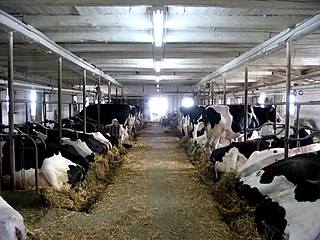
Dairy farming is one of the largest agricultural sectors in Canada. Dairy has a significant presence in all of the provinces and is one of the top two agricultural commodities in seven out of ten provinces.
Dairy Farmers of Ontario (DFO), is the marketing organization and regulatory body representing over 4,000 dairy farmers in Ontario, Canada. DFO was formerly known as the Ontario Milk Marketing Board (OMMB), which was established as result of the 1965 Ontario Milk Act. On August 1, 1995 the Ontario Milk Marketing Board and the Ontario Cream Producers' Marketing Board merged to form Dairy Farmers of Ontario.
A milk quota was one of the measures used by governments in the European Union to intervene in agriculture. Their purpose was to bring rising milk production under control. Milk quotas were attached to land holdings and represented a cap on the amount of milk that a farmer could sell every year without paying a levy. Milk quotas were assets and could be bought and sold or acquired or lost by other means and so there was a market for them.

Canada's supply management, abbreviated SM, is a national agricultural policy framework used across the country, which controls the supply of dairy, poultry and eggs through production and import controls and pricing mechanisms. The supply management system was authorized by the 1972 Farm Products Agencies Act, which established the two national agencies that oversee the system. The Agriculture and Agri-Food Canada federal department is responsible for both the Canadian Dairy Commission and its analogue for eggs, chicken and turkey products, the Farm Products Council of Canada. Five national supply management organizations, the SM-5 Organizations — Egg Farmers of Canada (EFC), Turkey Farmers of Canada (TFC), Chicken Farmers of Canada (CFC), the Canadian Hatching Egg Producers (CHEP) and the Ottawa-based Canadian Dairy Commission (CDC), a Crown corporation — in collaboration with provincial and national governing agencies, organizations and committees, administer the supply management system.

Agriculture in Wales has in the past been a major part of the economy of Wales, a largely rural country that forms part of the United Kingdom. Wales is mountainous and has a mild, wet climate. This results in only a small proportion of the land area being suitable for arable cropping, but grass for the grazing of livestock is present in abundance. As a proportion of the national economy, the importance of agriculture has become much reduced; a high proportion of the population now live in the towns and cities in the south of the country and tourism has become an important form of income in the countryside and on the coast. Arable cropping is limited to the flatter parts and elsewhere dairying and livestock farming predominate.

Trump administration farmer bailouts are a series of United States bailout programs introduced during the presidency of Donald Trump as a consequence of his "America First" economic policy to help US farmers suffering due to the US-China trade war and trade disputes with European Union, Japan, Canada, Mexico, and others. China and respectively European reconcilable tariffs imposed on peanut butter, soybeans, orange juice, and other agriculture products had hit hard, especially swing states, such as Iowa, Ohio, and Wisconsin.
References
 This article incorporates public domain material from Jasper Womach. Report for Congress: Agriculture: A Glossary of Terms, Programs, and Laws, 2005 Edition (PDF). Congressional Research Service.
This article incorporates public domain material from Jasper Womach. Report for Congress: Agriculture: A Glossary of Terms, Programs, and Laws, 2005 Edition (PDF). Congressional Research Service.